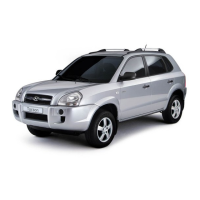Do you have a question about the Hyundai tucson 2012 and is the answer not in the manual?
Guidance on navigating the owner's manual and understanding its layout, including warnings, cautions, and notices.
Information on the types of fuel suitable for the vehicle and related cautions.
Advice on operating the vehicle safely, considering its design characteristics.
Recommendations for the initial period of vehicle use to ensure performance and longevity.
Explanation of the vehicle's event data recorder system and its function.
Explanation of various warning and indicator lights found on the instrument cluster.
Overview of the vehicle's interior features and controls.
Detailed explanation of the instrument cluster and its indicators.
Identification and location of key components in the engine compartment.
Instructions on adjusting front and rear seats, including headrests and armrests.
Proper usage, restraint system, and warnings related to seat belts.
Guidelines for installing and using child restraint systems for passenger safety.
Information on the SRS airbag system, its components, and operation.
Information on vehicle keys, key code numbers, and key operations.
How to use the remote keyless entry system for locking, unlocking, and alarm functions.
Explanation of the vehicle's theft-alarm system and its stages of operation.
Operation of door locks from inside and outside the vehicle, including auto lock features.
Instructions on opening and closing the tailgate, including safety precautions.
Operation of power windows, including auto up/down and lock functions.
Procedures for opening and closing the vehicle's hood, including safety warnings.
Instructions on opening and closing the fuel filler door and refueling safety.
How to operate the sunroof, including warning chimes and precautions.
Explanation of the electric power steering system and tilt/telescope adjustment.
Adjusting and folding outside rearview mirrors, with safety warnings and cautions.
Explanation of the instrument cluster, gauges, and illumination controls.
Explanation of various warning lights, including ECO, Air Bag, ABS, and others.
Explanation of warning lights for electronic brake force, parking brake, low fuel, and malfunctions.
Explanation of turn signal, light, high beam, and fog light indicators.
Explanation of engine oil pressure, shift pattern, and manual transaxle indicators.
Explanation of charging system, door/tailgate ajar, low fuel, and malfunction indicator lights.
Explanation of ESC, ESC OFF, and DBC indicators and their functions.
Explanation of AWD system warning, AWD LOCK indicator, and low tire pressure indicator.
Explanation of engine coolant, EPS, cruise, and key reminder warning lights.
Operation of the rearview camera system for backing up.
How to use the hazard warning flasher for emergencies.
Information on battery saver function and headlight escort function.
How to operate the headlights, parking lights, and turn signals using the control lever.
Explanation of headlight positions and auto light system operation.
How to operate high beam headlights and turn signals, including one-touch lane change.
Operation of front fog lights for improved visibility in poor conditions.
Controls for windshield wipers and washers, including speed settings.
How to operate windshield wipers and washers, and check fluid levels.
How to operate the rear window wiper and washer system.
Operation of map lamps and automatic turn off function for interior lights.
Operation of room lamp, luggage lamp, and glove box lamp.
How to operate windshield and rear window defrosters for clearing frost and fog.
How to activate the front windshield deicer for clearing frost and ice.
How to operate the manual climate control system, including heating and cooling.
Explanation of different airflow modes and their purposes in the climate control system.
How to operate instrument panel vents, temperature control, and air intake control.
Explanation of recirculated and outside air positions in the climate control system.
How to control fan speed and operate the air conditioning system.
Operation tips for the climate control system and air conditioning.
How to use the AUTO button for automatic climate control.
Simple operation of automatic heating and air conditioning by setting desired temperature.
Manual control of the heating and cooling system, and mode selection.
How to defrost outside windshield and use instrument panel vents and temperature control.
How to control fan speed and operate the air conditioning system, including OFF mode.
Instructions for defogging logic in manual and automatic climate control systems.
How to use the center console storage and glove box, with safety warnings.
How to open and use the sunglass holder, with safety warnings.
How to use the cigarette lighter and ashtray, with related cautions and warnings.
How to use cup holders and sunvisors, with warnings about hot liquids and unsecured items.
How to use the power outlet for accessories and related cautions.
How to set the digital clock and ensure floor mats are securely attached.
How to use the luggage net to secure items and important safety instructions for floor mats.
How to use the cargo security screen to hide items.
Guidelines for loading cargo on the roof rack, including weight limits and precautions.
Information about the vehicle's audio system and antenna.
How to use the audio controls located on the steering wheel.
Connecting audio devices via aux, USB, or iPod ports, and how the audio system works.
Explains normal conditions like fading, static, and station swapping for FM radio.
Situations where satellite radio reception may be difficult, and cell phone usage precautions.
Guidelines for handling and caring for CDs used with the audio system.
Overview of radio functions, setup options, volume control, and audio adjustments.
Detailed instructions for using radio functions, setup menus, and audio controls.
Detailed instructions for operating the CD player, including track selection and playback modes.
How to navigate through folders and use search functions for audio playback.
Important cautions and guidelines for using external USB devices with the audio system.
How to select and use AUX or USB modes for audio playback.
Detailed steps for operating the USB device with the audio system.
Overview of iPod controls and features for audio playback.
Detailed instructions for navigating and playing music from an iPod.
Overview of Bluetooth features, language settings, and phone operation.
How to receive, talk on the phone, and stream audio via Bluetooth.
Steps to access phone settings, pair a phone, and manage phone book entries.
How the system automatically connects to paired phones and sets connection priority.
How to delete paired phones, access advanced menus, and sync contacts.
How to activate voice recognition and its limitations, plus menu tree overview.
Methods for making phone calls using direct dialing or voice commands.
How to add and manage phone book entries by voice or phone.
How to delete registered names and adapt audio speaker output to user's voice.
A matrix showing key functions based on press duration and connection status.
Essential checks and preparations before starting to drive.
Regular checks for fluid levels and other vehicle components.
Steps to take before starting the engine, including seat adjustment and mirror settings.
Explanation of the different ignition switch positions (LOCK, ACC, ON, START).
Step-by-step instructions for starting the engine, with warnings and cautions.
How to operate the manual transmission, including shift patterns and cautions.
How to properly use the clutch pedal for shifting and holding the vehicle.
Information about the Hill-start Assist Control (HAC) activation and usage.
When and how to downshift for better control and fuel economy.
General advice for safe and efficient driving, including warnings about speed, steering, and rollovers.
How the automatic transaxle operates and selects gears.
Explanation of the different shift lever positions (P, R, N, D) and their functions.
Warnings about shifting into P (Park) while moving and leaving children unattended.
How to use the reverse gear.
Function of the neutral position and associated risks.
Normal forward driving position and how to achieve extra power.
How to select and use sports mode for rapid gearshifts.
Safety feature preventing shifting without brake pedal.
Procedure for overriding the shift lock system if it malfunctions.
How the ignition key interlock system works.
General advice for safe driving, including warnings about speed, steering, and rollovers.
How to start moving uphill, including the use of Hill-start Assist Control (HAC).
Important information about the HAC activation time.
Information on the AWD system, its operation, and limitations.
Warnings and limitations regarding off-road driving.
Explanation of the tight corner brake effect in AWD vehicles.
Caution regarding steering difficulty when turning sharply in AWD.
What to do if the AWD system warning light illuminates.
Description of AWD AUTO and AWD LOCK modes and their indicator lights.
Tips for safe operation of the AWD system, especially in challenging conditions.
Warnings about the dangers of driving across steep hills due to rollover risk.
Warnings about cornering, steering, and rollover risks with AWD vehicles.
Caution regarding how to hold the steering wheel when driving off-road.
Warnings about driving in high winds due to the vehicle's center of gravity.
Precautions and risks associated with driving through water.
Warning against spinning wheels at high speeds, which can damage tires.
Safety procedures and warnings when attempting to rock a stuck vehicle.
Explanation of the power brake system, including warnings and good braking practices.
Critical warnings and practices related to brake usage, including foot placement and descending hills.
How to identify worn brake pads via a warning sound.
How to apply and release the parking brake (foot and hand types).
Warning about the consequences of ignoring brake wear indicators.
Explanation of the ABS system, its operation, and warnings related to its use.
Warnings about driving maneuvers and road conditions affecting ABS and ESC.
Cautions related to ABS warning lights and potential malfunctions.
Explanation of the ESC system, its design, and operation.
How ESC operates, including indicator lights and when it is active or off.
Warnings about driving too fast, abrupt maneuvers, and hydroplaning with ESC.
How to turn ESC off and the implications of doing so.
Explanation of the VSM system and its operation.
How the HAC system prevents the vehicle from slipping back on hills.
Important information about the HAC activation time.
How the DBC system assists in descending steep hills.
How to use the cruise control system for maintaining speed.
Step-by-step instructions for setting the desired cruise control speed.
How to decrease speed and cancel cruise control.
How the Active ECO system operates to improve fuel efficiency.
Driving suggestions to improve fuel economy and reduce maintenance costs.
Critical warning against turning off the engine while the vehicle is in motion.
Suggestions for driving in adverse conditions like snow, ice, or mud.
Safety procedures and warnings when attempting to rock a stuck vehicle.
Advice for cornering safely, driving at night, and handling spinning tires.
Advice for driving safely in rainy and flooded conditions.
Proper tire maintenance, including inflation pressures and avoiding worn tires.
Recommendations for driving safely in winter conditions, including tire and chain usage.
Instructions and precautions for installing tire chains on drive wheels.
Recommendations for coolant, battery, and spark plug maintenance for winter.
Important points to consider before deciding to pull a trailer.
Importance of using correct hitch equipment and safety chain instructions.
General advice for driving with a trailer, emphasizing experience and familiarity.
How to drive safely on grades and park on hills, with towing warnings.
Importance of frequent maintenance checks when towing a trailer.
Table of maximum trailer weight and tongue load considerations.
Definition of vehicle capacity weight, seating, towing, and cargo capacities.
Information found on the certification label and warnings about overloading the vehicle.
Warnings about securing loose cargo and the consequences of overloading the vehicle.
Information on using hazard warning flashers for safety.
Actions to take if the engine stalls while driving or at an intersection.
Steps to take if a tire goes flat while driving.
Troubleshooting steps if the engine fails to start or turns over slowly.
Steps to take when the engine cranks but does not start.
Warning against push/pull starting due to potential damage and fire hazard.
Step-by-step procedure for jump starting a vehicle with a discharged battery.
Critical safety warnings about handling batteries and avoiding sparks.
Cautions about using the correct voltage jumper system to avoid damage.
Warnings related to recharging a vehicle battery.
Detailed steps for connecting jumper cables correctly.
Caution about connecting battery cables to prevent overheating or cracking.
Warning against tow-starting a vehicle due to collision risks.
Actions to take if the engine overheats, including stopping and checking coolant.
Warning about keeping hands and clothing away from moving engine parts.
Warning about removing the radiator cap when the engine is hot.
Caution about coolant leaks indicating a potential system issue.
Explanation of the TPMS indicators for low tire pressure and system malfunctions.
Recommendations for monthly tire pressure checks and using the correct inflation pressure.
What to do if TPMS or malfunction indicators do not illuminate correctly.
What the low tire pressure telltale indicates and immediate actions to take.
Note that the compact spare tire is not equipped with a TPMS sensor.
Warnings about the dangers of driving on significantly underinflated tires.
How cold weather affects tire pressure and the need for adjustment.
Procedures for changing a flat tire on a vehicle equipped with TPMS.
Caution against using tire sealant, which can damage TPMS sensors.
Importance of using correct wheel studs to ensure proper mounting.
Warning about the dangers of damaged wheel studs.
Importance of checking spare tire pressure after installation.
Warning about the limitations of TPMS regarding severe tire damage and vehicle instability.
Warning that unauthorized modifications may void the user's authority to operate equipment.
Location and identification of the jack and tools for changing a tire.
Instructions for safely using the jack and reducing the risk of injury.
Safety warnings about changing tires, including location and personnel safety.
Procedures for removing and storing the spare tire and tools.
Step-by-step instructions for changing a vehicle tire.
Warnings to prevent vehicle movement and ensure personnel safety during tire changes.
Warning about using the correct jack location to prevent injury.
How to identify worn tires and when to replace them.
Warnings about tire wear, damage, and the risks of mixing tire types.
Essential practices for maintaining tires for safety and fuel economy.
Information on recommended tire inflation pressures and how to check them.
Warnings about the severe risks of driving on underinflated tires.
General advice on checking tire pressure, including warm vs. cold tires and valve caps.
Caution about releasing air from warm tires.
Warnings about the consequences of overinflated or underinflated tires.
Recommendations for rotating tires to equalize tread wear and improve performance.
Importance of proper wheel alignment and balance for tire life and vehicle handling.
Warnings about the risks of tire failure due to wear or damage.
Proper procedures for compact spare tire replacement and wheel replacement.
Importance of using equivalent wheels when replacing them.
Factors affecting tire traction and how to maintain it.
Importance of wheel alignment and balance for tire life.
How to identify worn tires and when to replace them.
Explanation of tire sidewall information, including size and identification codes.
How to interpret tire size designations (width, aspect ratio, construction, rim diameter, load index, speed rating).
How to interpret wheel size designations (rim width, contour, diameter).
Explanation of tire speed ratings and ply composition.
How to check tire age based on the DOT code and when tires should be replaced.
Explanation of tire ply composition (steel, nylon, polyester) and construction codes.
Warnings about tire degradation over time and the risks of using old tires.
Explanation of tire temperature grades and warnings about heat buildup.
Warnings about heat buildup from underinflation, overloading, or high speeds leading to tire failure.
Definitions of tire-related terms like air pressure, aspect ratio, and bead.
Visual identification of different types of fuses (blade, cartridge, multi, main).
Critical warnings about replacing fuses with the correct rating and avoiding temporary fixes.
Caution about using metal objects to remove fuses.
Step-by-step instructions for replacing fuses in the instrument panel.
How to use the memory fuse and replace fuses in the engine compartment.
Description of the instrument panel and engine compartment fuse panels.
Detailed list of fuses in the instrument panel and their protected components.
Detailed list of fuses in the engine compartment and their protected components.
Safety precautions when working on vehicle lights.
Safety precautions when working on vehicle lights.
Caution about using bulbs with the correct wattage to avoid damage.
Advice to consult a dealer if lacking tools or expertise for bulb replacement.
Instructions for replacing various exterior light bulbs.
Step-by-step instructions for replacing headlight bulbs.
Warnings about handling halogen bulbs due to pressurized gas and heat.
Instructions for replacing turn signal and position light bulbs.
What to do if front fog light bulbs are not operating.
What to do if the side repeater light bulb is not operating.
Instructions for replacing bulbs in the rear combination lights.
Procedures for removing and reinstalling the rear combination light assembly.
Step-by-step instructions for replacing interior light bulbs.
Safety warning about working on interior lights when the ignition is on.
Caution about cleaning interior light components.
General cautions for exterior cleaning and maintenance.
Recommendations for washing and maintaining the vehicle's finish.
How to wash the vehicle properly to protect its finish.
Cautions about washing the vehicle in direct sunlight or with harsh cleaners.
Warning to test brakes after washing the vehicle.
Importance of waxing for paint protection and how to do it properly.
Importance of promptly repairing scratches and stone chips to prevent rust.
Cautions about cleaning the vehicle's body with dry cloths or harsh cleaners.
Cautions about using cleaners on plastic and leather components.
How to clean and protect bright metal parts from corrosion.
Importance of flushing the underbody to remove corrosive materials.
How to clean and protect aluminum wheels without damaging the finish.
Warning to test brakes after washing the vehicle.
How to protect the vehicle from corrosion through proper cleaning and maintenance.
Identifying common factors that lead to vehicle corrosion.
Specific advice for vehicles exposed to high-corrosion environments.
Explanation of how moisture contributes to corrosion.
Importance of keeping the vehicle clean, especially the underside.
Advice on parking the vehicle in a dry, well-ventilated garage.
How to maintain paint and trim, including touch-up repairs and bird dropping removal.
Importance of keeping the vehicle interior dry to prevent corrosion.
General precautions for cleaning interior surfaces and avoiding damage.
Instructions for cleaning vinyl and fabric upholstery and interior trim.
How to clean seat belt webbing with mild soap solutions.
How to clean interior window glass to prevent fogging.
Caution about avoiding contact between liquids and electrical components.
Caution that improper cleaners may affect fabric appearance and fire resistance.
Caution about not scratching the inside of the rear window.
Cautions when cleaning leather seats and steering wheels.
Overview of the emission control system and its importance.
Precautions for performing tests with the ESC system active.
Explanation of the crankcase ventilation system and its function.
How the evaporative emission control system prevents fuel vapor release.
Function of the canister in storing fuel vapors.
How the PCSV valve controls evaporated fuel.
Explanation of the exhaust emission control system for reducing emissions.
Warnings against modifying the vehicle and potential warranty issues.
Safety precautions regarding carbon monoxide in exhaust fumes.
Warnings about the dangers of carbon monoxide in exhaust gases.
California warning about chemicals in vehicle components and fluids.
Precautions for operating the vehicle with a catalytic converter, including fuel type and avoiding misuse.
Warnings about the hot exhaust system igniting flammable materials.
Special handling instructions for perchlorate materials.
Table showing vehicle dimensions in millimeters.
Table listing wattage for various exterior and interior light bulbs.
Information on tire sizes, inflation pressures, and wheel specifications.
Table listing recommended lubricants, volumes, and classifications for various vehicle systems.
Chart showing recommended engine oil viscosity based on temperature.
How to locate and check the vehicle identification number (VIN).
Information found on the vehicle certification label.
Location of the tire label providing recommended pressures and specifications.
Location of the engine number stamped on the engine block.
Consumer information and contact details for Hyundai regional offices.
How to report vehicle safety defects to NHTSA and Hyundai.
Information on the binding arbitration agreement for warranty disputes.
Guidance on navigating the owner's manual and understanding its layout, including warnings, cautions, and notices.
Information on the types of fuel suitable for the vehicle and related cautions.
Advice on operating the vehicle safely, considering its design characteristics.
Recommendations for the initial period of vehicle use to ensure performance and longevity.
Explanation of the vehicle's event data recorder system and its function.
Explanation of various warning and indicator lights found on the instrument cluster.
Overview of the vehicle's interior features and controls.
Detailed explanation of the instrument cluster and its indicators.
Identification and location of key components in the engine compartment.
Instructions on adjusting front and rear seats, including headrests and armrests.
Proper usage, restraint system, and warnings related to seat belts.
Guidelines for installing and using child restraint systems for passenger safety.
Information on the SRS airbag system, its components, and operation.
Information on vehicle keys, key code numbers, and key operations.
How to use the remote keyless entry system for locking, unlocking, and alarm functions.
Explanation of the vehicle's theft-alarm system and its stages of operation.
Operation of door locks from inside and outside the vehicle, including auto lock features.
Instructions on opening and closing the tailgate, including safety precautions.
Operation of power windows, including auto up/down and lock functions.
Procedures for opening and closing the vehicle's hood, including safety warnings.
Instructions on opening and closing the fuel filler door and refueling safety.
How to operate the sunroof, including warning chimes and precautions.
Explanation of the electric power steering system and tilt/telescope adjustment.
Adjusting and folding outside rearview mirrors, with safety warnings and cautions.
Explanation of the instrument cluster, gauges, and illumination controls.
Explanation of various warning lights, including ECO, Air Bag, ABS, and others.
Explanation of warning lights for electronic brake force, parking brake, low fuel, and malfunctions.
Explanation of turn signal, light, high beam, and fog light indicators.
Explanation of engine oil pressure, shift pattern, and manual transaxle indicators.
Explanation of charging system, door/tailgate ajar, low fuel, and malfunction indicator lights.
Explanation of ESC, ESC OFF, and DBC indicators and their functions.
Explanation of AWD system warning, AWD LOCK indicator, and low tire pressure indicator.
Explanation of engine coolant, EPS, cruise, and key reminder warning lights.
Operation of the rearview camera system for backing up.
How to use the hazard warning flasher for emergencies.
Information on battery saver function and headlight escort function.
How to operate the headlights, parking lights, and turn signals using the control lever.
Explanation of headlight positions and auto light system operation.
How to operate high beam headlights and turn signals, including one-touch lane change.
Operation of front fog lights for improved visibility in poor conditions.
Controls for windshield wipers and washers, including speed settings.
How to operate windshield wipers and washers, and check fluid levels.
How to operate the rear window wiper and washer system.
Operation of map lamps and automatic turn off function for interior lights.
Operation of room lamp, luggage lamp, and glove box lamp.
How to operate windshield and rear window defrosters for clearing frost and fog.
How to activate the front windshield deicer for clearing frost and ice.
How to operate the manual climate control system, including heating and cooling.
Explanation of different airflow modes and their purposes in the climate control system.
How to operate instrument panel vents, temperature control, and air intake control.
Explanation of recirculated and outside air positions in the climate control system.
How to control fan speed and operate the air conditioning system.
Operation tips for the climate control system and air conditioning.
How to use the AUTO button for automatic climate control.
Simple operation of automatic heating and air conditioning by setting desired temperature.
Manual control of the heating and cooling system, and mode selection.
How to defrost outside windshield and use instrument panel vents and temperature control.
How to control fan speed and operate the air conditioning system, including OFF mode.
Instructions for defogging logic in manual and automatic climate control systems.
How to use the center console storage and glove box, with safety warnings.
How to open and use the sunglass holder, with safety warnings.
How to use the cigarette lighter and ashtray, with related cautions and warnings.
How to use cup holders and sunvisors, with warnings about hot liquids and unsecured items.
How to use the power outlet for accessories and related cautions.
How to set the digital clock and ensure floor mats are securely attached.
How to use the luggage net to secure items and important safety instructions for floor mats.
How to use the cargo security screen to hide items.
Guidelines for loading cargo on the roof rack, including weight limits and precautions.
Information about the vehicle's audio system and antenna.
How to use the audio controls located on the steering wheel.
Connecting audio devices via aux, USB, or iPod ports, and how the audio system works.
Explains normal conditions like fading, static, and station swapping for FM radio.
Situations where satellite radio reception may be difficult, and cell phone usage precautions.
Guidelines for handling and caring for CDs used with the audio system.
Overview of radio functions, setup options, volume control, and audio adjustments.
Detailed instructions for using radio functions, setup menus, and audio controls.
Detailed instructions for operating the CD player, including track selection and playback modes.
How to navigate through folders and use search functions for audio playback.
Important cautions and guidelines for using external USB devices with the audio system.
How to select and use AUX or USB modes for audio playback.
Detailed steps for operating the USB device with the audio system.
Overview of iPod controls and features for audio playback.
Detailed instructions for navigating and playing music from an iPod.
Overview of Bluetooth features, language settings, and phone operation.
How to receive, talk on the phone, and stream audio via Bluetooth.
Steps to access phone settings, pair a phone, and manage phone book entries.
How the system automatically connects to paired phones and sets connection priority.
How to delete paired phones, access advanced menus, and sync contacts.
How to activate voice recognition and its limitations, plus menu tree overview.
Methods for making phone calls using direct dialing or voice commands.
How to add and manage phone book entries by voice or phone.
How to delete registered names and adapt audio speaker output to user's voice.
A matrix showing key functions based on press duration and connection status.
Essential checks and preparations before starting to drive.
Regular checks for fluid levels and other vehicle components.
Steps to take before starting the engine, including seat adjustment and mirror settings.
Explanation of the different ignition switch positions (LOCK, ACC, ON, START).
Step-by-step instructions for starting the engine, with warnings and cautions.
How to operate the manual transmission, including shift patterns and cautions.
How to properly use the clutch pedal for shifting and holding the vehicle.
Information about the Hill-start Assist Control (HAC) activation and usage.
When and how to downshift for better control and fuel economy.
General advice for safe and efficient driving, including warnings about speed, steering, and rollovers.
How the automatic transaxle operates and selects gears.
Explanation of the different shift lever positions (P, R, N, D) and their functions.
Warnings about shifting into P (Park) while moving and leaving children unattended.
How to use the reverse gear.
Function of the neutral position and associated risks.
Normal forward driving position and how to achieve extra power.
How to select and use sports mode for rapid gearshifts.
Safety feature preventing shifting without brake pedal.
Procedure for overriding the shift lock system if it malfunctions.
How the ignition key interlock system works.
General advice for safe driving, including warnings about speed, steering, and rollovers.
How to start moving uphill, including the use of Hill-start Assist Control (HAC).
Important information about the HAC activation time.
Information on the AWD system, its operation, and limitations.
Warnings and limitations regarding off-road driving.
Explanation of the tight corner brake effect in AWD vehicles.
Caution regarding steering difficulty when turning sharply in AWD.
What to do if the AWD system warning light illuminates.
Description of AWD AUTO and AWD LOCK modes and their indicator lights.
Tips for safe operation of the AWD system, especially in challenging conditions.
Warnings about the dangers of driving across steep hills due to rollover risk.
Warnings about cornering, steering, and rollover risks with AWD vehicles.
Caution regarding how to hold the steering wheel when driving off-road.
Warnings about driving in high winds due to the vehicle's center of gravity.
Precautions and risks associated with driving through water.
Warning against spinning wheels at high speeds, which can damage tires.
Safety procedures and warnings when attempting to rock a stuck vehicle.
Explanation of the power brake system, including warnings and good braking practices.
Critical warnings and practices related to brake usage, including foot placement and descending hills.
How to identify worn brake pads via a warning sound.
How to apply and release the parking brake (foot and hand types).
Warning about the consequences of ignoring brake wear indicators.
Explanation of the ABS system, its operation, and warnings related to its use.
Warnings about driving maneuvers and road conditions affecting ABS and ESC.
Cautions related to ABS warning lights and potential malfunctions.
Explanation of the ESC system, its design, and operation.
How ESC operates, including indicator lights and when it is active or off.
Warnings about driving too fast, abrupt maneuvers, and hydroplaning with ESC.
How to turn ESC off and the implications of doing so.
Explanation of the VSM system and its operation.
How the HAC system prevents the vehicle from slipping back on hills.
Important information about the HAC activation time.
How the DBC system assists in descending steep hills.
How to use the cruise control system for maintaining speed.
Step-by-step instructions for setting the desired cruise control speed.
How to decrease speed and cancel cruise control.
How the Active ECO system operates to improve fuel efficiency.
Driving suggestions to improve fuel economy and reduce maintenance costs.
Critical warning against turning off the engine while the vehicle is in motion.
Suggestions for driving in adverse conditions like snow, ice, or mud.
Safety procedures and warnings when attempting to rock a stuck vehicle.
Advice for cornering safely, driving at night, and handling spinning tires.
Advice for driving safely in rainy and flooded conditions.
Proper tire maintenance, including inflation pressures and avoiding worn tires.
Recommendations for driving safely in winter conditions, including tire and chain usage.
Instructions and precautions for installing tire chains on drive wheels.
Recommendations for coolant, battery, and spark plug maintenance for winter.
Important points to consider before deciding to pull a trailer.
Importance of using correct hitch equipment and safety chain instructions.
General advice for driving with a trailer, emphasizing experience and familiarity.
How to drive safely on grades and park on hills, with towing warnings.
Importance of frequent maintenance checks when towing a trailer.
Table of maximum trailer weight and tongue load considerations.
Definition of vehicle capacity weight, seating, towing, and cargo capacities.
Information found on the certification label and warnings about overloading the vehicle.
Warnings about securing loose cargo and the consequences of overloading the vehicle.
Information on using hazard warning flashers for safety.
Actions to take if the engine stalls while driving or at an intersection.
Steps to take if a tire goes flat while driving.
Troubleshooting steps if the engine fails to start or turns over slowly.
Steps to take when the engine cranks but does not start.
Warning against push/pull starting due to potential damage and fire hazard.
Step-by-step procedure for jump starting a vehicle with a discharged battery.
Critical safety warnings about handling batteries and avoiding sparks.
Cautions about using the correct voltage jumper system to avoid damage.
Warnings related to recharging a vehicle battery.
Detailed steps for connecting jumper cables correctly.
Caution about connecting battery cables to prevent overheating or cracking.
Warning against tow-starting a vehicle due to collision risks.
Actions to take if the engine overheats, including stopping and checking coolant.
Warning about keeping hands and clothing away from moving engine parts.
Warning about removing the radiator cap when the engine is hot.
Caution about coolant leaks indicating a potential system issue.
Explanation of the TPMS indicators for low tire pressure and system malfunctions.
Recommendations for monthly tire pressure checks and using the correct inflation pressure.
What to do if TPMS or malfunction indicators do not illuminate correctly.
What the low tire pressure telltale indicates and immediate actions to take.
Note that the compact spare tire is not equipped with a TPMS sensor.
Warnings about the dangers of driving on significantly underinflated tires.
How cold weather affects tire pressure and the need for adjustment.
Procedures for changing a flat tire on a vehicle equipped with TPMS.
Caution against using tire sealant, which can damage TPMS sensors.
Importance of using correct wheel studs to ensure proper mounting.
Warning about the dangers of damaged wheel studs.
Importance of checking spare tire pressure after installation.
Warning about the limitations of TPMS regarding severe tire damage and vehicle instability.
Warning that unauthorized modifications may void the user's authority to operate equipment.
Location and identification of the jack and tools for changing a tire.
Instructions for safely using the jack and reducing the risk of injury.
Safety warnings about changing tires, including location and personnel safety.
Procedures for removing and storing the spare tire and tools.
Step-by-step instructions for changing a vehicle tire.
Warnings to prevent vehicle movement and ensure personnel safety during tire changes.
Warning about using the correct jack location to prevent injury.
How to identify worn tires and when to replace them.
Warnings about tire wear, damage, and the risks of mixing tire types.
Essential practices for maintaining tires for safety and fuel economy.
Information on recommended tire inflation pressures and how to check them.
Warnings about the severe risks of driving on underinflated tires.
General advice on checking tire pressure, including warm vs. cold tires and valve caps.
Caution about releasing air from warm tires.
Warnings about the consequences of overinflated or underinflated tires.
Recommendations for rotating tires to equalize tread wear and improve performance.
Importance of proper wheel alignment and balance for tire life and vehicle handling.
Warnings about the risks of tire failure due to wear or damage.
Proper procedures for compact spare tire replacement and wheel replacement.
Importance of using equivalent wheels when replacing them.
Factors affecting tire traction and how to maintain it.
Importance of wheel alignment and balance for tire life.
How to identify worn tires and when to replace them.
Explanation of tire sidewall information, including size and identification codes.
How to interpret tire size designations (width, aspect ratio, construction, rim diameter, load index, speed rating).
How to interpret wheel size designations (rim width, contour, diameter).
Explanation of tire speed ratings and ply composition.
How to check tire age based on the DOT code and when tires should be replaced.
Explanation of tire ply composition (steel, nylon, polyester) and construction codes.
Warnings about tire degradation over time and the risks of using old tires.
Explanation of tire temperature grades and warnings about heat buildup.
Warnings about heat buildup from underinflation, overloading, or high speeds leading to tire failure.
Definitions of tire-related terms like air pressure, aspect ratio, and bead.
Visual identification of different types of fuses (blade, cartridge, multi, main).
Critical warnings about replacing fuses with the correct rating and avoiding temporary fixes.
Caution about using metal objects to remove fuses.
Step-by-step instructions for replacing fuses in the instrument panel.
How to use the memory fuse and replace fuses in the engine compartment.
Description of the instrument panel and engine compartment fuse panels.
Detailed list of fuses in the instrument panel and their protected components.
Detailed list of fuses in the engine compartment and their protected components.
Safety precautions when working on vehicle lights.
Safety precautions when working on vehicle lights.
Caution about using bulbs with the correct wattage to avoid damage.
Advice to consult a dealer if lacking tools or expertise for bulb replacement.
Instructions for replacing various exterior light bulbs.
Step-by-step instructions for replacing headlight bulbs.
Warnings about handling halogen bulbs due to pressurized gas and heat.
Instructions for replacing turn signal and position light bulbs.
What to do if front fog light bulbs are not operating.
What to do if the side repeater light bulb is not operating.
Instructions for replacing bulbs in the rear combination lights.
Procedures for removing and reinstalling the rear combination light assembly.
Step-by-step instructions for replacing interior light bulbs.
Safety warning about working on interior lights when the ignition is on.
Caution about cleaning interior light components.
General cautions for exterior cleaning and maintenance.
Recommendations for washing and maintaining the vehicle's finish.
How to wash the vehicle properly to protect its finish.
Cautions about washing the vehicle in direct sunlight or with harsh cleaners.
Warning to test brakes after washing the vehicle.
Importance of waxing for paint protection and how to do it properly.
Importance of promptly repairing scratches and stone chips to prevent rust.
Cautions about cleaning the vehicle's body with dry cloths or harsh cleaners.
Cautions about using cleaners on plastic and leather components.
How to clean and protect bright metal parts from corrosion.
Importance of flushing the underbody to remove corrosive materials.
How to clean and protect aluminum wheels without damaging the finish.
Warning to test brakes after washing the vehicle.
How to protect the vehicle from corrosion through proper cleaning and maintenance.
Identifying common factors that lead to vehicle corrosion.
Specific advice for vehicles exposed to high-corrosion environments.
Explanation of how moisture contributes to corrosion.
Importance of keeping the vehicle clean, especially the underside.
Advice on parking the vehicle in a dry, well-ventilated garage.
How to maintain paint and trim, including touch-up repairs and bird dropping removal.
Importance of keeping the vehicle interior dry to prevent corrosion.
General precautions for cleaning interior surfaces and avoiding damage.
Instructions for cleaning vinyl and fabric upholstery and interior trim.
How to clean seat belt webbing with mild soap solutions.
How to clean interior window glass to prevent fogging.
Caution about avoiding contact between liquids and electrical components.
Caution that improper cleaners may affect fabric appearance and fire resistance.
Caution about not scratching the inside of the rear window.
Cautions when cleaning leather seats and steering wheels.
Overview of the emission control system and its importance.
Precautions for performing tests with the ESC system active.
Explanation of the crankcase ventilation system and its function.
How the evaporative emission control system prevents fuel vapor release.
Function of the canister in storing fuel vapors.
How the PCSV valve controls evaporated fuel.
Explanation of the exhaust emission control system for reducing emissions.
Warnings against modifying the vehicle and potential warranty issues.
Safety precautions regarding carbon monoxide in exhaust fumes.
Warnings about the dangers of carbon monoxide in exhaust gases.
California warning about chemicals in vehicle components and fluids.
Precautions for operating the vehicle with a catalytic converter, including fuel type and avoiding misuse.
Warnings about the hot exhaust system igniting flammable materials.
Special handling instructions for perchlorate materials.
Table showing vehicle dimensions in millimeters.
Table listing wattage for various exterior and interior light bulbs.
Information on tire sizes, inflation pressures, and wheel specifications.
Table listing recommended lubricants, volumes, and classifications for various vehicle systems.
Chart showing recommended engine oil viscosity based on temperature.
How to locate and check the vehicle identification number (VIN).
Information found on the vehicle certification label.
Location of the tire label providing recommended pressures and specifications.
Location of the engine number stamped on the engine block.
Consumer information and contact details for Hyundai regional offices.
How to report vehicle safety defects to NHTSA and Hyundai.
Information on the binding arbitration agreement for warranty disputes.
| Brand | Hyundai |
|---|---|
| Model | tucson 2012 |
| Category | Automobile |
| Language | English |












